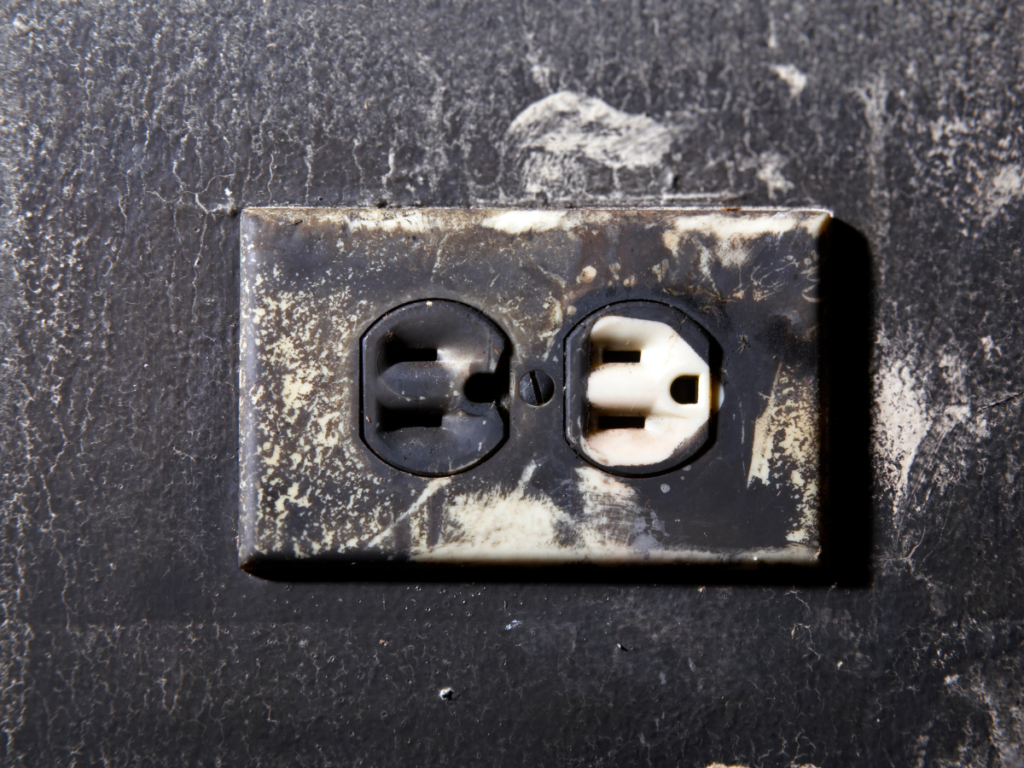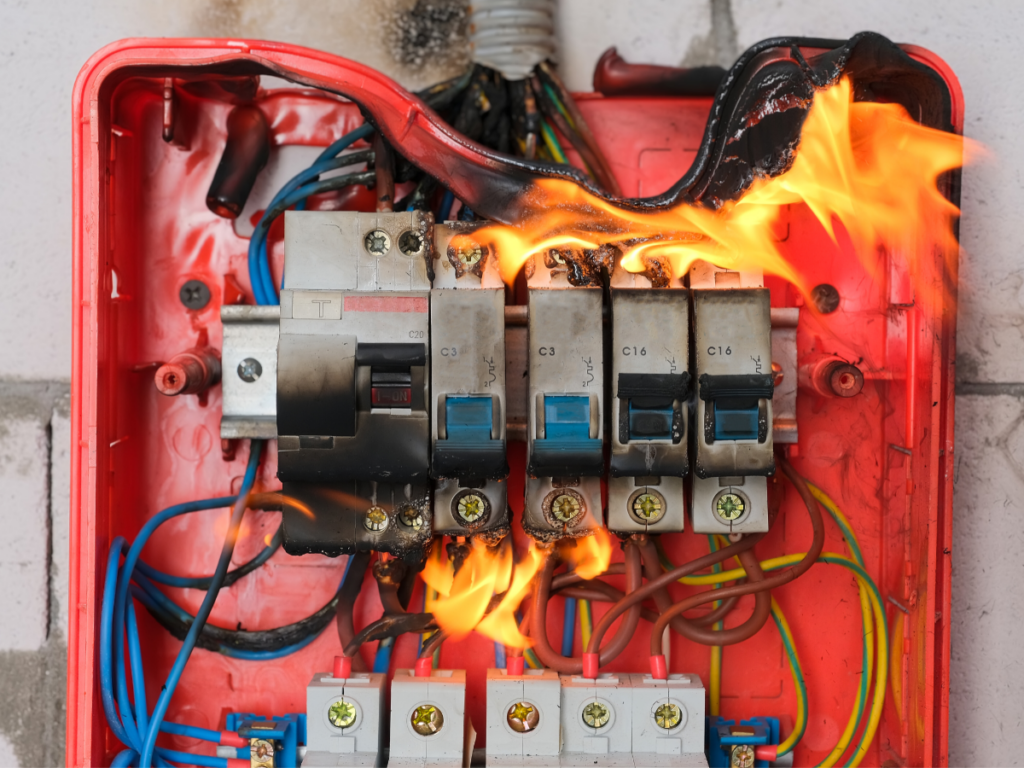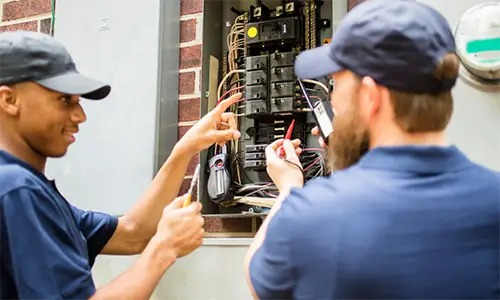
If you’ve noticed flickering lights in your home or smelled a burning odor, you might be concerned about an electrical short circuit. Short circuiting occurs when an electrical current travels along an unintended path of lower resistance and causes the power to surge.
An electrical short can damage appliances and electronics or cause a fire, so it’s important to know their signs and what to do if you suspect one. If you think you might have an electrical short, don’t put up with any malarky, call Mister Sparky.
What Are the Signs of an Electrical Short Circuit?
The following signs indicate your electrical system has a short:
- Flickering lights
- Frequently tripping breakers
- Faint burning odor
- Burn marks on outlets
- Scorched wires
- Blowing fuses
- Sparks
These signs are a warning that you have a problem. If you ignore them, you will risk your home and family. It’s best to find the short and get help immediately if you experience short circuiting in your home. Follow the steps below to find and deal with an electrical short.
1. Gather Tools to Find an Electrical Short
You should gather a few tools to find an electrical short. These include a digital multimeter, circuit tester, contact voltage tester, screwdrivers, and insulated pliers. You’ll also need a flashlight. Before you start, turn off the power to your house. All of your tools should be insulated to protect you, and you should not work in standing water.
2. Turn the Power Off
Turn off the power to your circuit breaker. Once the power is off, flip the breakers to the off and then the on position. Resetting your breakers can help to clear glitches that might be interfering with your circuits.
2. Check the Suspected Circuit Breaker
Find the circuit breaker you believe is associated with the problem. Using your digital multimeter, check to see whether there is any voltage present in the circuit. If you detect voltage, turn off the other breakers and test them to see if more than one circuit is involved.
3. Look for Damage
Look at the wires for damage. This might include fraying, worn wires, or burn marks. Look for anything that appears unusual.
4. Perform Continuity Tests
Next, use your multimeter to test your switches, electrical wires, and outlets. This helps you identify whether there are any breaks in the circuit. These components should complete the circuit correctly.
5. Inspect Hidden Areas
Make sure to inspect the wiring in your basement, attic, and your home’s exterior. In many cases, a short circuit will originate in one of these areas and be overlooked. These areas can be especially to blame for chronic electrical problems, so don’t skip inspecting them.
6. Call a Professional Electrician
Electrical work is not something you should attempt as a do-it-yourself project. If you don’t know what you’re doing, you can place yourself at risk of electrical shock. If you discover a short and have identified which circuit is involved, it’s best to leave the repairs to the electricians at Mister Sparky. We have the expertise and tools necessary to identify and repair the issue that’s causing your electrical short circuit, and we know how to do so safely to avoid hazards to your home and family.
Take Preventative Measures
Once we’ve repaired your short circuit, it’s a good idea to take preventative measures to prevent future electrical shorts. While these are common problems that can’t always be avoided, you can take the following steps to reduce your risks.
1. Schedule Annual Electrical Inspections
Schedule annual electrical inspections to confirm your home’s wiring and electrical components are in good working order. If your home is older and hasn’t been rewired, annual inspections can help to identify issues before they turn into major problems.
2. Minimize Electricity Use During Storms
When it’s storming outside, it’s best to minimize your use of electricity. Lightning can damage your electronics and appliances when you use them during storms. Short circuits are also more common during thunderstorms. Unplug your electronics and appliances when there’s a lot of lightning outside to protect them.
3. Regularly Inspect Your Outlets
Make a habit of regularly inspecting your outlets. Look for burn marks, sparks, buzzing, or clicking sounds. These signs indicate you should call Mister Sparky to identify and fix the problem to avoid a fire or electrical shock. Don’t use an outlet that shows these signs. Turn off the circuit breaker for that area and unplug anything that might be plugged into it.
4. Consider an Electrical Panel Upgrade
If you experience frequent electrical shorts and have an older electrical panel, you might want to consider an upgrade. New electrical panels use modern technology and features to distribute electricity better. Upgrading to a new electrical panel improves safety and prevents circuit overloads and shorts.
5. Install GFCIs
Ground fault circuit interrupters (GFCIs) should be installed in your bathroom, outdoors, and anywhere else where there might be wet conditions. When a GFCI detects a fault, it interrupts the power and shuts the outlet off.
6. Avoid Overloading Outlets

Don’t plug too many things into a single outlet. If you have too many things plugged into a single circuit, it can overheat and cause a short. Instead, use a power strip with a circuit breaker to plug in multiple devices.
7. Don’t Place Cords Near Heat Sources
You should avoid having your cords near heat sources. If you do, they can overheat and lead to an electrical short.
Contact Mister Sparky
Short circuits can be more than annoying. Without prompt repairs, an electrical short can cause a fire or shock. If you are experiencing the signs of an electrical short, it’s best to call a professional electrician to fix it for you safely. Mister Sparky has delivered high-quality electrical work since 1996 and can solve any electrical issue you might have. Don’t put up with malarky, call Mister Sparky in Tampa, FL today!
